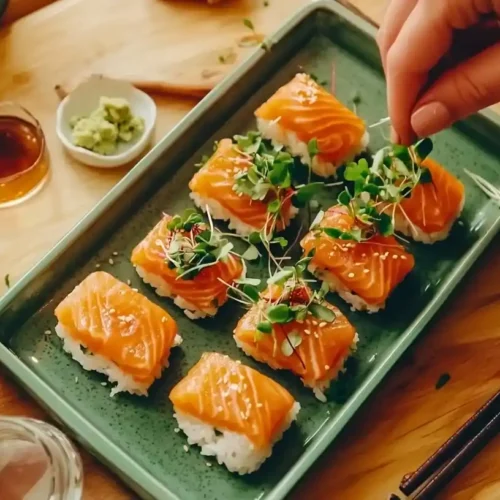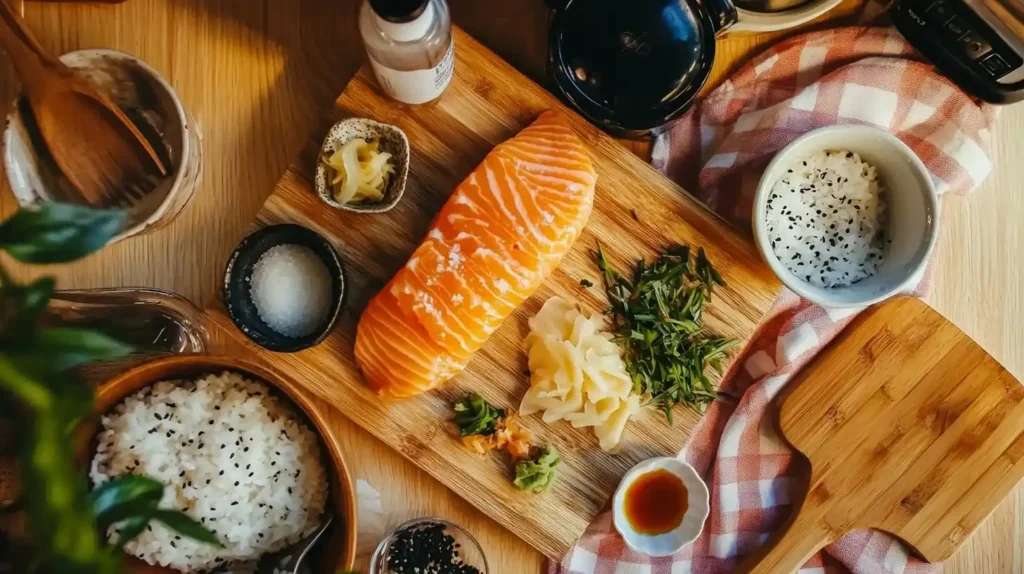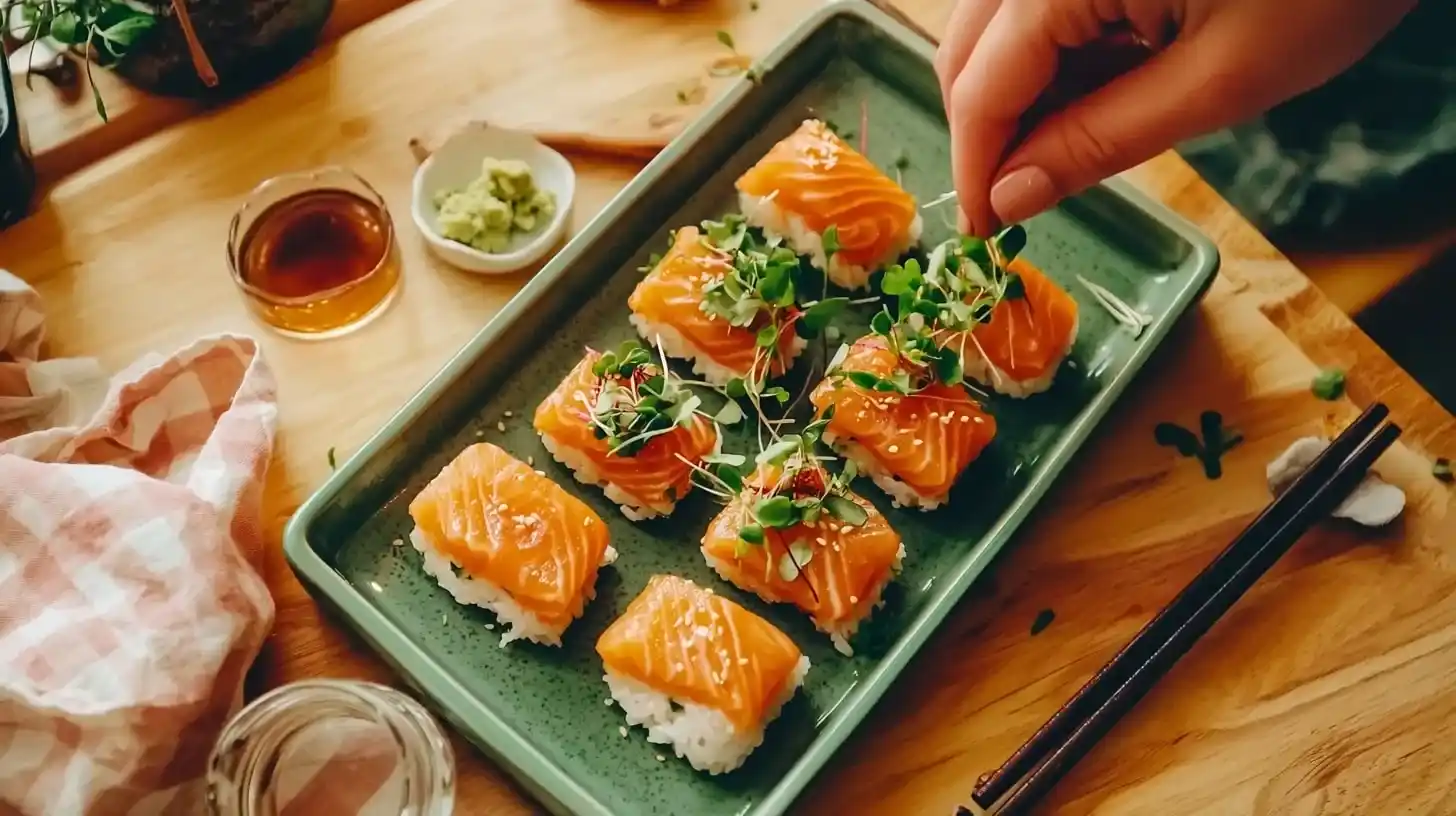“You MADE this?” My husband’s expression of disbelief as I presented homemade salmon nigiri at our family dinner table still makes me smile. His reaction – equal parts surprise and admiration – confirmed what I’d suspected: this simple Japanese classic carries an undeserved reputation for difficulty.
My journey into nigiri-making began during the pandemic lockdown when our family’s favorite Japanese restaurant closed temporarily. My oldest son’s birthday was approaching, and salmon nigiri had always been his special request. With determination and several video tutorials, I discovered that creating this elegant dish at home requires more precision than complexity.
What most surprised me was how quickly my children embraced both the preparation and consumption of salmon nigiri. Even my typically cautious middle child eagerly formed rice balls while my youngest delighted in carefully placing each salmon slice. This Japanese classic has since become our family’s favorite way to transform an ordinary weeknight into a special occasion.

Homemade Salmon Nigiri
Ingredients
- 2 cups Japanese short-grain rice
- 2 cups water
- ¼ cup rice vinegar
- 2 tablespoons sugar
- 1 teaspoon salt
- 8 oz sushi-grade salmon (from a reputable fishmonger)
- Wasabi paste
- Soy sauce (for serving)
- Pickled ginger (for serving)
Instructions
- Rinse the rice thoroughly in cold water until the water runs clear, about 5-7 times.
- Cook rice according to package directions, either in a rice cooker or on the stovetop.
- While rice cooks, prepare sushi vinegar by combining rice vinegar, sugar, and salt in a small saucepan. Heat gently until sugar dissolves, then cool to room temperature.
- Once rice is cooked, transfer to a large wooden or glass bowl (avoid metal bowls which can react with the vinegar).
- Pour the vinegar mixture over the hot rice and fold gently with a cutting motion using a rice paddle or wooden spoon, being careful not to mash the grains.
- Fan the rice while mixing to help it cool quickly and develop a glossy texture.
- Cover rice with a damp towel and let it come to room temperature, about 10-15 minutes.
- While rice cools, slice salmon against the grain into thin rectangles, approximately ¼ inch thick and sized to cover your rice balls.
- Prepare a small bowl of water with a touch of rice vinegar for moistening hands (prevents sticking).
- With moistened hands, take about 2 tablespoons of rice and gently compress into an oval shape with a flat bottom.
- Place a small dab of wasabi on top of each rice ball.
- Drape a slice of salmon over the rice, gently pressing it to adhere to the rice and wasabi.
- Arrange on a serving platter and serve immediately with soy sauce and pickled ginger on the side.
Notes
Table of Contents
Why You’ll Love This Salmon Nigiri Recipe
TThis homemade salmon nigiri has remained a family favorite for good reason:
- Impressive simplicity: Creates restaurant-quality results with just a few ingredients and steps
- Nutritious powerhouse: Delivers lean protein, healthy fats, and essential nutrients in an elegant package
- Kid-friendly preparation: Offers perfect opportunities for little hands to help with safe, engaging tasks
- Customizable experience: Easily adapts to different preferences and comfort levels with raw fish
For more globally-inspired recipes that bring international flavors to your family table, visit our International Lunch Inspirations: Global Flavors Made Simple collection. You might also enjoy our Family-Friendly Lunch Recipes: Effortless Meals for Busy Parents for additional simple yet satisfying ideas.
For those wondering Is salmon nigiri raw?, this recipe uses traditionally raw fish, but I’ll share safe shopping practices and alternatives for those concerned about serving raw fish.
If you’re curious about various Japanese fish preparations, What is nigiri vs sashimi? explains the key differences between these often-confused Japanese delicacies.
Simple Ingredients for Salmon Nigiri
Show Ingredients Image Simple, fresh ingredients transform into elegant salmon nigiri – proving that impressive Japanese cuisine doesn’t require complicated components!

For restaurant-quality salmon nigiri at home, you’ll need: For the sushi rice:
- 2 cups Japanese short-grain rice
- 2 cups water
- ¼ cup rice vinegar
- 2 tablespoons sugar
- 1 teaspoon salt
For the nigiri:
- 8 oz sushi-grade salmon (fresh from a reputable fishmonger)
- Wasabi paste
- Soy sauce (for serving)
- Pickled ginger (for serving)
My grandmother never prepared Japanese cuisine in her Kentucky kitchen, but her principles of quality ingredients apply perfectly here: “The fresher your starting point, the less you need to do to make it wonderful.” This wisdom particularly applies to the salmon – its quality will determine your nigiri’s success.
For those concerned about nutrition, Is salmon nigiri healthy for you? explains the significant nutritional benefits of this protein-rich, omega-3 filled preparation.
Easy Step-by-Step Preparation
- Rinse the rice thoroughly until water runs clear. My oldest insists on counting exactly seven rinses, a superstition we’ve maintained since our first successful attempt.
- Cook rice according to package directions, either in a rice cooker or stovetop method. Perfect rice forms the foundation of great nigiri.
- While rice cooks, prepare sushi vinegar by combining rice vinegar, sugar, and salt in a small saucepan. Heat gently until sugar dissolves, then cool to room temperature.
- Once rice is cooked, transfer to a large wooden bowl (traditional) or glass bowl. Avoid metal, which can react with the vinegar.
- Pour the vinegar mixture over the hot rice and fold gently with a cutting motion, being careful not to mash the grains. My middle child claims this folding technique is “like tucking the rice into a vinegar blanket.”
- Fan the rice while mixing to help it cool quickly and develop a glossy texture. My youngest delights in this task, using a paper fan we decorated specifically for our Japanese cooking adventures.
- Cover rice with a damp towel and let it come to room temperature, about 10-15 minutes.
- While rice cools, slice salmon against the grain into thin rectangles, approximately 1/4 inch thick and sized to cover your rice balls.
- Prepare a small bowl of water with a touch of rice vinegar for moistening hands (prevents sticking).
- With moistened hands, take about 2 tablespoons of rice and gently compress into an oval shape with a flat bottom. My grandmother’s advice for any hand-formed food applies here: “Firm enough to hold together, gentle enough to keep it tender.”
- Place a small dab of wasabi on top of each rice ball.
- Drape a slice of salmon over the rice, gently pressing it to adhere to the rice.
The entire preparation takes about 30 minutes (plus rice cooking time), making this achievable even on busy weeknights when you want something special.
My Best Tips for Perfect Salmon Nigiri
Through many family nigiri-making sessions, I’ve gathered several tips for success:
For the best texture: Use proper Japanese short-grain rice, often labeled “sushi rice.” My first attempt with long-grain rice resulted in nigiri that fell apart immediately – a lesson in using the right ingredients.
For food safety: Purchase salmon from a reputable fishmonger and inform them you’ll be using it for sushi. Quality matters tremendously for both safety and flavor.
For beautiful presentation: Cut salmon against the grain in one smooth motion with a very sharp knife. My husband’s role in our nigiri-making involves sharpening the knife before each session – a small detail that significantly impacts results.
For authentic flavor: Serve traditionally with wasabi, pickled ginger, and good-quality soy sauce. For those wondering about flavor profiles, What does salmon nigiri taste like? offers a detailed description of this delicate culinary experience.
Answers to Your Salmon Nigiri Questions
Q: Can I use grocery store salmon for nigiri? Regular supermarket salmon isn’t intended for raw consumption. For safety, use fish labeled “sushi-grade” or “sashimi-grade” from reputable fishmongers. My first salmon purchase involved a detailed conversation with our local fish seller about proper handling.
Q: How do I make this kid-friendly? Many children actually enjoy simple nigiri, often more readily than complex sushi rolls. For hesitant eaters, start with fully cooked salmon (briefly seared or poached) on top of the rice. My youngest transitioned from cooked to traditional preparation over several months.
Q: How long does salmon nigiri keep? Salmon nigiri is best consumed immediately after preparation. Unlike some foods that improve with time, freshness is essential here. My mother’s wisdom applies perfectly: “Some dishes aren’t meant for leftovers – they’re meant to be enjoyed completely in the moment.”
Salmon Nigiri: Japanese Simplicity at Your Family Table
There’s something magical about a dish that’s simultaneously simple and sophisticated. Salmon nigiri embodies this duality – requiring minimal ingredients and straightforward technique while delivering an elegant experience that feels special even on ordinary weeknights.
The first time my children proudly served their grandparents homemade nigiri, I witnessed the unique satisfaction that comes from creating something perceived as “restaurant-only” in our home kitchen. Their confidence in presenting this Japanese classic reflected newfound culinary pride.
I hope this recipe brings the same joy and culinary adventure to your family table, proving that impressive Japanese cuisine belongs in home kitchens alongside more familiar fare.
With warmth, Sophia





